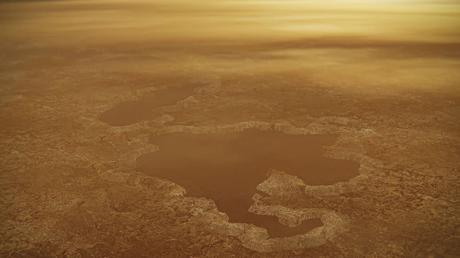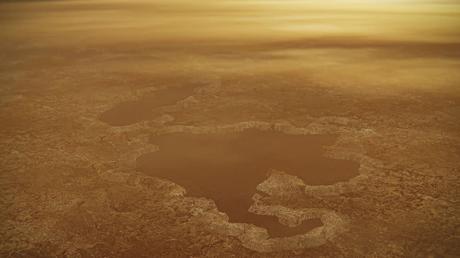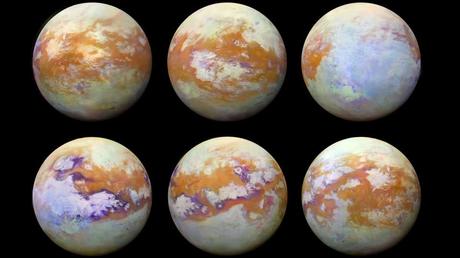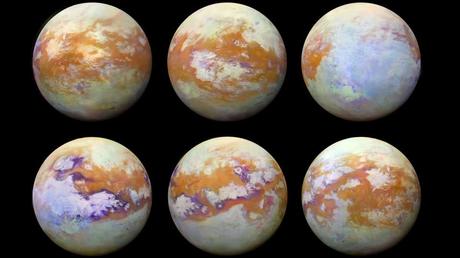The disappearing "magic islands" on Saturn's largest moon, Titan, have intrigued scientists since NASA's Cassini mission discovered them during flybys a decade ago. Now researchers think they have unraveled the secrets of the phenomenon.
These short-lived features were initially thought to be the result of effervescent gas bubbles, but astronomers now think they are honeycomb-like glaciers made of organic material falling onto the moon's surface.
Scientists consider Titan one of the most fascinating moons in our solar system because it shares some similarities with Earth. In many ways, however, it also presents a bewildering alien landscape.
Titan, larger than both our moon and the planet Mercury, is the only moon in our solar system with a thick atmosphere. The atmosphere is mostly nitrogen with some methane, which gives Titan its faint orange appearance. Titan's atmospheric pressure is about 60% greater than Earth's, so it exerts the kind of pressure humans feel when swimming about 50 feet below the ocean's surface, according to NASA.
Titan is also the only other world in our solar system with Earth-like liquid bodies on its surface - but its rivers, lakes and seas are composed of liquid ethane and methane, which form clouds and cause liquid gas to rain from the sky. .
The Cassini mission orbiter, which carried the Huygens probe that landed on Titan in 2005, made more than 100 flybys of Titan between 2004 and 2017 to reveal much of what scientists know about the moon today.
One of the most mysterious aspects of Titan are its magical islands, which scientists observe as moving points of light on Titan's sea surface that can last a few hours, several weeks, or longer. Cassini's radar images captured the inexplicably bright areas in Ligeia Mare, the second-largest liquid body on Titan's surface. The sea is 50% larger than Lake Superior and consists of liquid methane, ethane and nitrogen.
The story continues
Astronomers thought that these areas might be clumping bubbles of nitrogen gas, true islands made of floating solids, or features attributed to waves (although the waves are only a few millimeters high).


Planetary scientist Xinting Yu, an assistant professor at the University of Texas at San Antonio, focused on analyzing the connections between Titan's atmosphere, liquid bodies and solid materials that fall as snow to see if they are related to the magical islands.
"I wanted to investigate whether the magical islands could actually be organic substances floating on the surface, like pumice that can float on water here on Earth before eventually sinking," said Yu, lead author of a study published January 4 in the journal Geophysical Research Letters. .
Scientists are trying to understand as much as possible about Titan before sending a special mission to the moon. The Dragonfly mission, led by the Johns Hopkins Applied Physics Laboratory in collaboration with NASA, is expected to launch in 2028 and reach Titan in the 2030s.
Analyzing an unusual world
A wide range of organic molecules exist in Titan's upper atmosphere, including nitriles, hydrocarbons and benzene. The surface temperature is so cold at minus 290 degrees Fahrenheit (minus 179 degrees Celsius) that the rivers and lakes are carved by liquid methane - the way rocks and lava helped form features and channels on Earth.
The organic molecules in Titan's atmosphere bind together in clumps before freezing and falling to the moon's surface. Plains and dark dunes of organic material have been discovered across Titan, and scientists believe these features are largely caused by Titan's 'snow'.
But what happens when the hydrocarbon snow falls onto the eerily smooth surfaces of Titan's liquid gas lakes and rivers? Yu and her colleagues examined the different scenarios that could occur.
Yu's team determined that the solid organic material falling from the upper atmosphere would not dissolve if it landed on Titan's liquid bodies because they are already saturated with organic particles.


"In order to see the magical islands, they cannot float for a while and then sink," Yu said. "They should float for a while, but not forever."
But liquid ethane and methane have low surface tension, meaning it's harder for solids to float on them.
Yu's team simulated several models and determined that the frozen solid material would not float unless it was porous, such as honeycomb or Swiss cheese. The small particles probably wouldn't float on their own either unless they were large enough.
The team's analysis resulted in a scenario in which the frozen solid hydrocarbons clumped close to shore, then broke off and floated across the surface like glaciers on Earth. Liquid methane slowly seeps into the frozen clumps, eventually causing them to disappear from view.
In addition, a possible thin layer of frozen solids on Titan's seas and lakes could explain why the moon's liquid bodies are so slippery, the researchers said.
Meet Titan
Over the next decade, Dragonfly is expected to primarily explore the organic material plains in Titan's equatorial region, rather than the liquid bodies.
The helicopter lander will sample materials on Titan's surface, study the potential habitability of its unique environments and determine what chemical processes occur on the moon.
Organic chemicals essential to life on Earth are also found on Titan, such as nitrogen, oxygen and other carbon-based molecules. Beneath Titan's thick crust, made of ice, is an internal ocean of salty water, similar to other intriguing moons from the ocean world orbiting Saturn, such as Enceladus, or Jupiter's moon Europa - which are considered some of the best places to search for life beyond Earth.
Titan sounds inhospitable, but it's possible that conditions there are conducive to life that relies on different chemistry and shapes in ways beyond our current understanding, NASA said.
For more CNN news and newsletters, create an account at CNN.com
